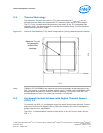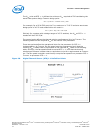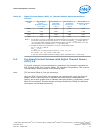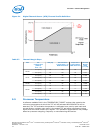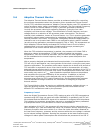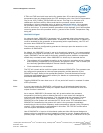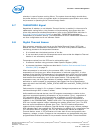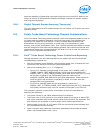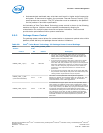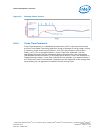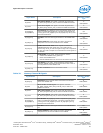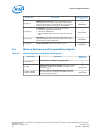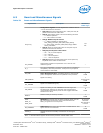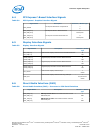
have the capability of generating interrupts using the core's local APIC. Refer to the
Intel
®
64 and IA-32 Architectures Software Developer’s Manual for specific register
and programming details.
Digital Thermal Sensor Accuracy (Taccuracy)
The error associated with DTS measurements will not exceed ±5 °C within the entire
operating range.
Intel
®
Turbo Boost Technology Thermal Considerations
Intel Turbo Boost Technology allows processor cores and integrated graphics cores to
run faster than the baseline frequency. During a turbo event, the processor can
exceed its TDP power for brief periods. Turbo is invoked opportunistically and
automatically as long as the processor is conforming to its temperature, power
delivery, and current specification limits. Thus, thermal solutions and platform cooling
that are designed to less than thermal design guidance may experience thermal and
performance issues since more applications will tend to run at or near the maximum
power limit for significant periods of time.
Intel
®
Turbo Boost Technology Power Control and Reporting
Package processor core and internal graphics core powers are self monitored and
correspondingly reported out.
• With the processor turbo disabled, rolling average power over 5 seconds will not
exceed the TDP rating of the part for typical applications.
• With turbo enabled (see Figure 22 on page 81)
— For the PL1: Package rolling average of the power set in POWER_LIMIT_1
(TURBO_POWER_LIMIT MSR 0610h bits [14:0]) over time window set in
POWER_LIMIT_1_TIME (TURBO_POWER_LIMIT MSR 0610h bits [23:17]) must
be less than or equal to the TDP package power as read from the
PACKAGE_POWER_SKU MSR 0614h for typical applications. Power control is
valid only when the processor is operating in turbo. PL1 lower than the
package TDP is not guaranteed.
— For the PL2: Package power will be controlled to a value set in
POWER_LIMIT_2 (TURBO_POWER_LIMIT MSR 0610h bits [46:32]). Occasional
brief power excursions may occur for periods of less than 10 ms over PL2.
The processor monitors its own power consumption to control turbo behavior,
assuming the following:
• The power monitor is not 100% tested across all processors.
• The Power Limit 2 (PL2) control is only valid for power levels set at or above TDP
and under workloads with similar activity ratios as the product TDP workload. This
also assumes the processor is working within other product specifications.
• Setting power limits (PL1 or PL2) below TDP are not ensured to be followed, and
are not characterized for accuracy.
• Under unknown work loads and unforeseen applications the average processor
power may exceed Power Limit 1 (PL1).
5.8.1
5.9
5.9.1
Thermal Management—Processor
Desktop 4th Generation Intel
®
Core
™
Processor Family, Desktop Intel
®
Pentium
®
Processor Family, and Desktop Intel
®
Celeron
®
Processor Family
December 2013 Datasheet – Volume 1 of 2
Order No.: 328897-004 79



